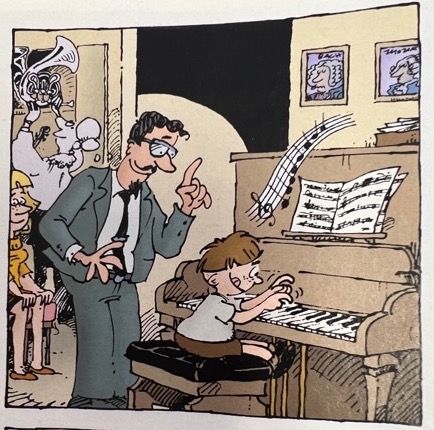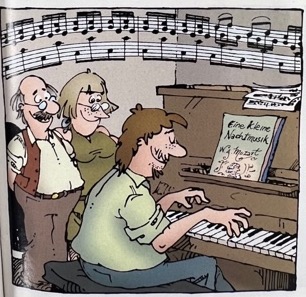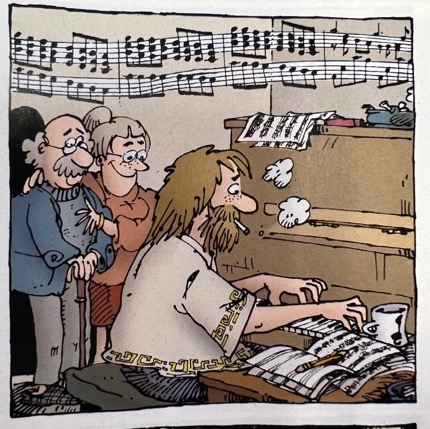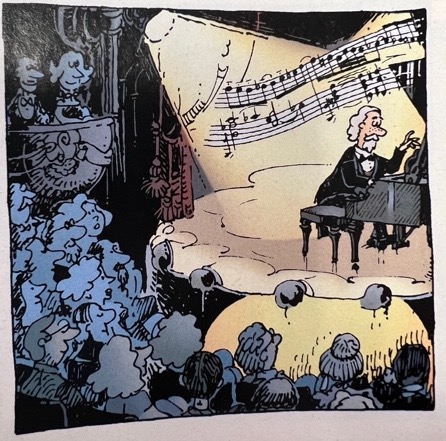Purpose
Comic creators select from these various forms of musical depictions based on their ability to serve the purpose of the comic. In some comics, music is a plot device that can reveal important information to further the narrative or create a new conflict that the characters must resolve. Likewise, music can reinforce the environment of a scene in order to mimic and heighten the sense of realism in the comic. For example, a creator may elect to depict a percussionist playing the drums, and then have onomatopoeia of varying font sizes surround the characters in the scene in order to demonstrate their physical proximity to the drum set as a way of spatializing the scene. Lastly, musical depictions can characterize figures in the story, particularly those that are defined through their association with music.
Narrative and Plot
Music can further the plot of a comic through both subject matter and visual formatting. The subject matter can include instruments, songs, singers, or bands that advance the narrative by either introducing new conflicts or resolving the issues. In terms of formatting, the flow of the music, particularly the lyrics, serves as a visual tracking device from which audiences can follow the progression of events.
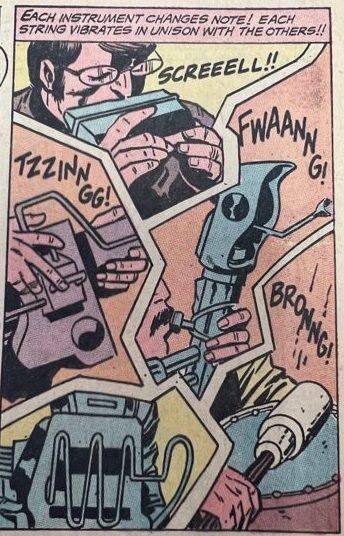
Superman’s Pal Jimmy Olsen, “A Big Thing in a Deep Scottish Lake,” December 1971
Writer and Penciller: Jack Kirby
Inker: Vince Colletta
Publisher: DC Comics
Page 14
In this issue of Superman’s Pal Jimmy Olsen, Jimmy Olsen fights villains disguised as musicians at San Diego Comic-Con. Olsen becomes aware of their villainy when he hears them play their instruments, which produce irregular and unnerving sounds. This panel depicts these sounds, which include “Tzzinngg!” and “Fwaang!” The sounds are metallic and aggressive, which is reinforced by the jagged gutter lines that jut in between each instrument and the unusual look of the instruments themselves. Not only does this panel reinforce the notion that instruments are often depicted through onomatopoeia, but it also serves the plot of the story because the instruments are the source of Olsen’s realization and instigates the narrative build-up to when Olsen eventually fights these musical meanies.
Redbone: The True Story of a Native American Rock Band, September 2020
Author: Christian Staebler and Sonia Paoloni
Translated by: Edward Gauvin
Lettering: Frank Cvetkovic
Publisher: Steinkis Groupe
Page 56
The graphic novel Redbone: The True Story of a Native American Rock Band is a biographical narrative about the formation and cultural influence of the band Redbone. Throughout the comic, red, flowing lines such as the one seen on this page course from panel to panel as a visual representation of their songwriting and singing process. The lines mimic the five-bar staff as a further reinforcement of the connection to music, as does the inclusion of their song lyrics within the lines themselves. In terms of narrative, these lines are diegetic, meaning that they are actually heard by the characters within the scene. Their prospective producer hears these lyrics and follows them as they walk into the house, just as the audience visually follows the progression of the flow from panel to panel. The swirling, streaming lyrics compel the story forward at a momentous occasion for the band and a turning point in the graphic novel.
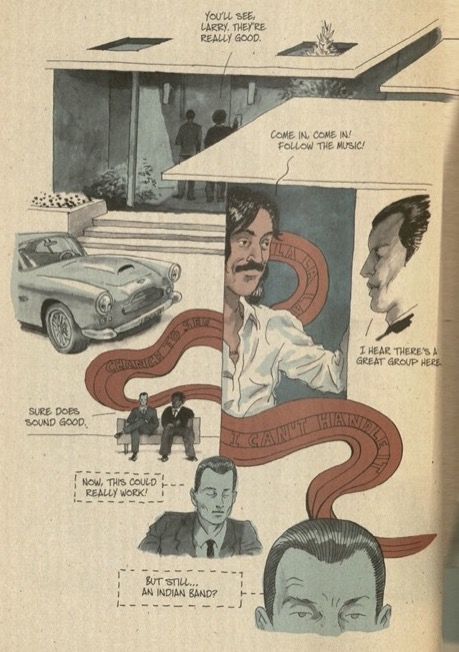
View More Examples of Narrative and Plot
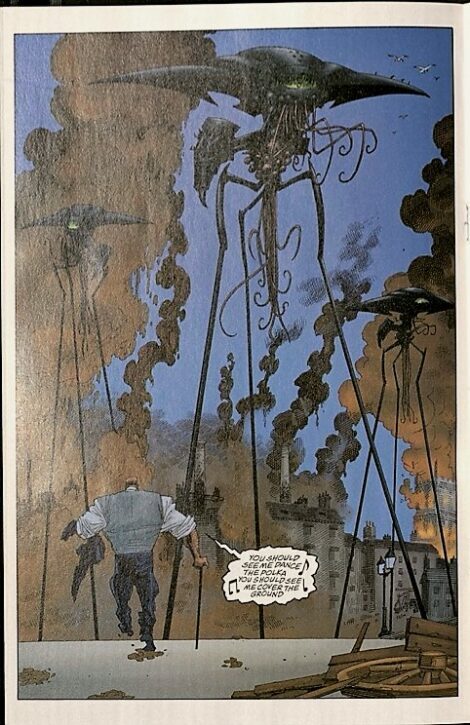
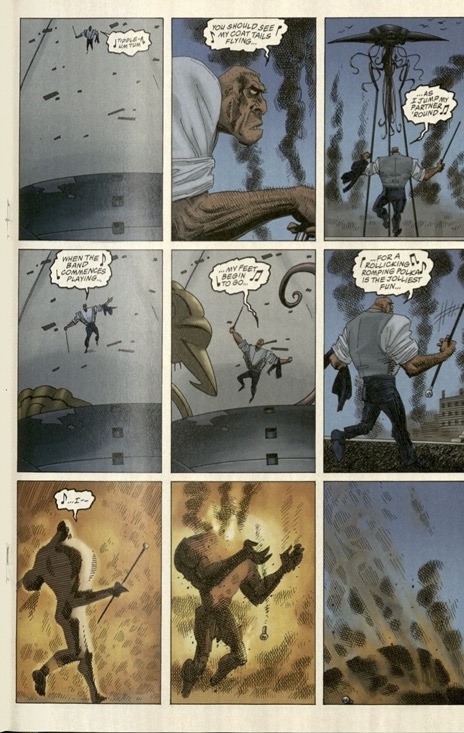
Page 16 of League of Extraordinary Gentlemen II #6, “You Should See Me Dance the Polka,” November 2003
Writer: Alan Moore
Artist: Kevin O’Neill
Colorist: Benedict DiMagmaliw
Letterer: Bill Oakley
Publisher: Top Shelf Productions
The League of Extraordinary Gentlemen involves a team of superheroes that travel throughout time to fight villains and historical anomalies. This series of pages features one character, Hyde, fighting a swarm of Martians by singing “You Should See Me Dance the Polka” from the musical Dr. Jekyll and Mr. Hyde. As is conventional with depictions of lyrics, the speech bubbles are bumpy and include music notes. Alan Moore is known for his integration of songs into his comics because songs, especially pre-existing ones, create sounds that “escape the boundaries of the silent page” due to the reader’s awareness of them (Summers 124). On these pages, the music heightens the action of the page by creating additional awareness of sound in an already action-heavy scene. The song also serves a pragmatic purpose for the heroes because it distracts the Martians and is a visual reference point for the readers as they track Hyde’s fight with the aliens.
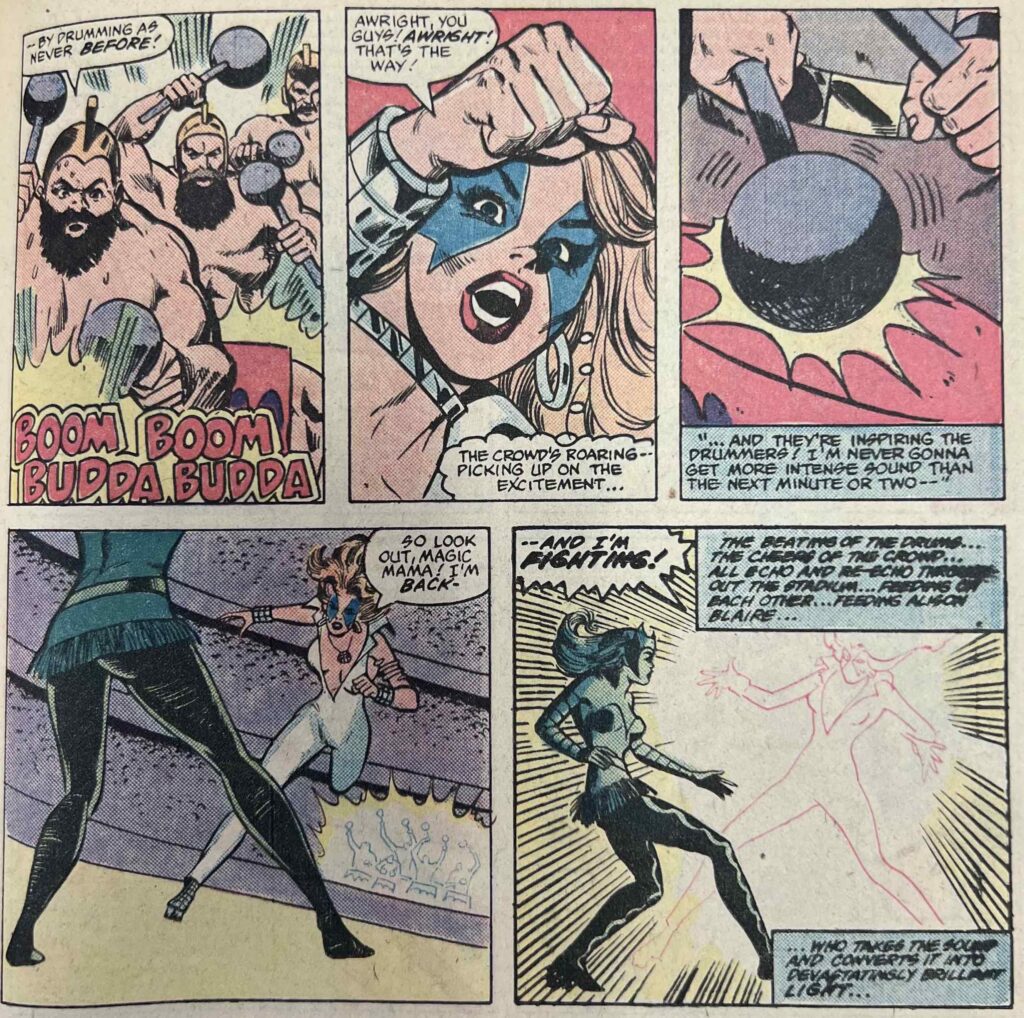
Dazzler #16, “Black Magic Woman,” June 1982
Writer: Danny Fingeroth
Penciller: Frank Springer
Inker: Vince Colletta
Colorist: Don Warfield
Letterer: Janice Chiang
Publisher: Marvel Comics
Page 22
The drums in this scene from Dazzler #16 function within the plot by giving Dazzler the power that she needs to defeat Enchantress, an Asgardian villain. Depicted with conventional onomatopoetic stylings and piercing motion lines that convey the intensity of the drumming, the “Boom Boom Buddha Buddha” of the percussion becomes the source of her strength, and ultimately her success. The drums are so crucial to the plot that their presence continues to be known visually in the two panels that follow Dazzler’s rejuvenated strength, first in the foreground and later in the background when Dazzler finally starts to overcome Enchantress.
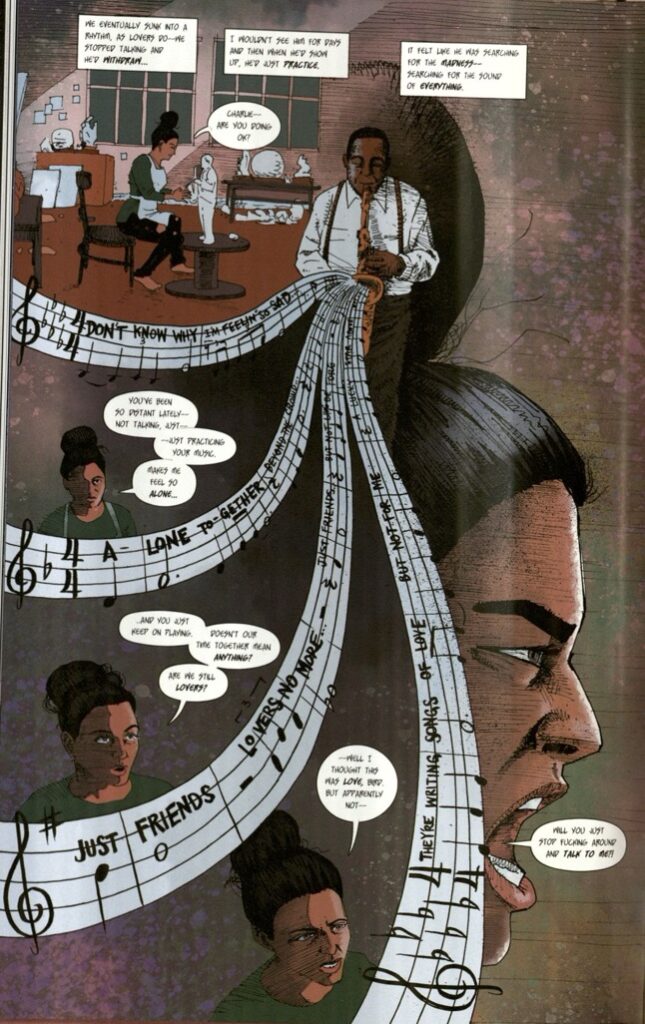
Chasing the Bird: Charlie Parker in California, 2020
Author: Dave Chisholm
Colors By: Peter Markowski
Publisher: Z2 Comics
Page 86
In this splash page from Chasing the Bird, Charlie Parker and his wife are depicted as in a strained relationship brought on by his music and inability to communicate. His wife is the only one speaking and working to resolve the conflicts, while his only source of sound is the music that streams from his instrument. His lack of verbal communication reflects the idea of his music being the source of tension in the relationship, as do the lyrics shout lost love and sadness that flow along the musical staves. It is unclear whether these lyrics are actually heard by the characters or are included in order to act as musical gutters that establish the melancholy tone of the splash page, but they nevertheless help accentuate the frustration between the two characters. These relationship issues continue through the next several pages of the graphic novel, with this page serving as a starting point for the ensuing conflicts.
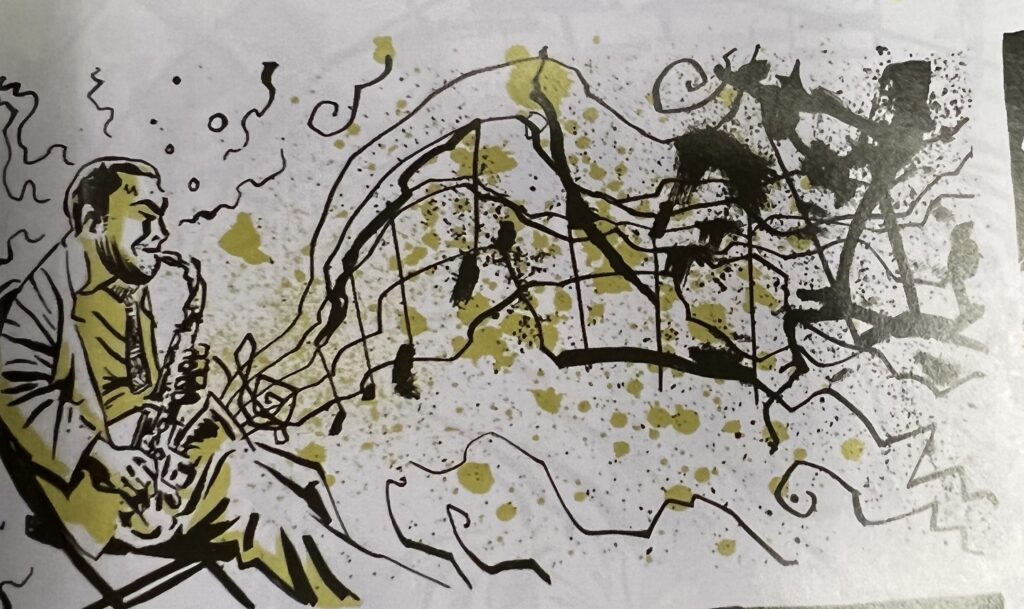
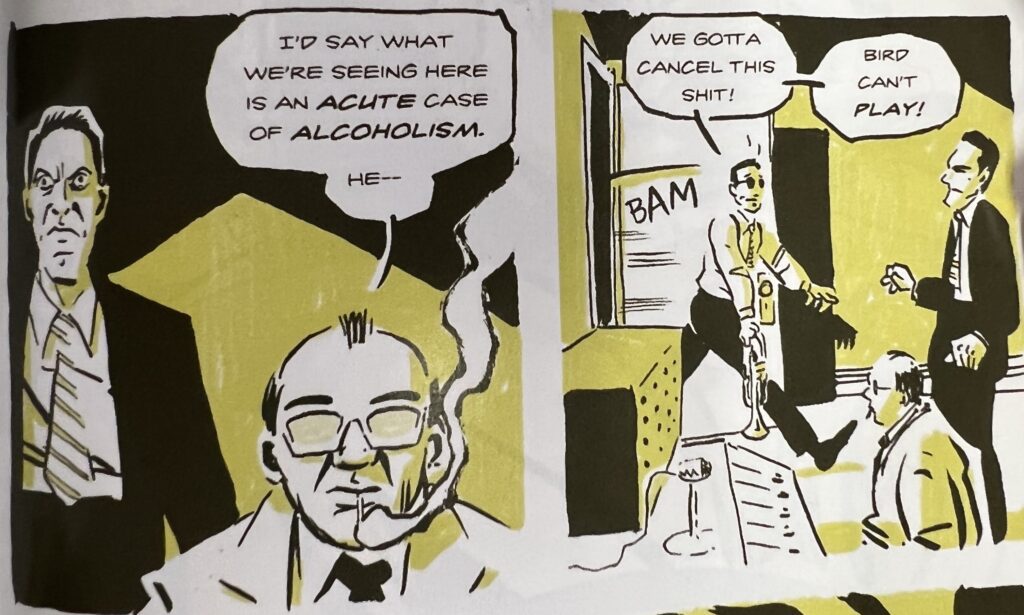
Chasing the Bird: Charlie Parker in California, 2020
Author: Dave Chisholm
Colors By: Peter Markowski
Publisher: Z2 Comics
Page 114
In this first panel, Parker’s music is drawn in a way that contrasts with any other portrayal of his music thus far. While still on a musical staff, the notes and lines are rough, broken, and jagged. While the reader is as surprised as the producers that are watching him perform, the reality of the situation soon becomes apparent: he has “an acute sense of alcoholism” which negatively affects the way he plays. Because music is fundamental to Parker as a person, this stark contrast in musical styling to the uniformity and beauty of previous depictions of his playing, such as when it was depicted as a series of pink squares, demonstrates the extent to which he has been changed by the prognosis. His alcoholism is a shock and has a lasting impact on the narrative, just as it impacts his music and the depictions of it.
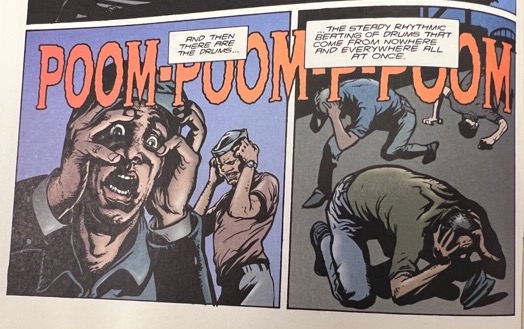
Abe Sapien: Drums of the Dead #1, March 1998
Writers and Artists: Mike Mignola and Brian McDonald
Colorists: Dave Stewart and Alex Sinclair
Letterer: Pat Brosseau
Publisher: Dark Horse Comics
Page 2
In this story, Abe Sapien investigates a series of mysterious deaths on a ship, and it is soon discovered that the cause of the deaths is a drumming noise that kills those who hear it. The drumming is indicated through a “Poom-poom” sound drawn in bright orange lettering that contrasts the dark and subdued colors of the rest of the comic. As seen in this series of panels, the drumming noise also breaks through the gutters as if unconstrained by the normal conventions of a comic book. This portrayal serves to accentuate the intensity and strength of this drumming, signifying it as a force of immense power. The consideration and characteristics given to these percussive sounds convey to readers that the drums play a key role in the central conflict of the narrative.
Environment
The environment of a comic describes both the physical and visual landscape of the scene as well as the passage of time. In terms of a physical landscape, music can convey the depth and atmosphere of the space that the plot or characters occupy. Likewise, because sound, unlike images, exists within a certain period of time, music can also situate the narrative temporally. Both of these integrations of music further the authenticity of the environment for the audience.
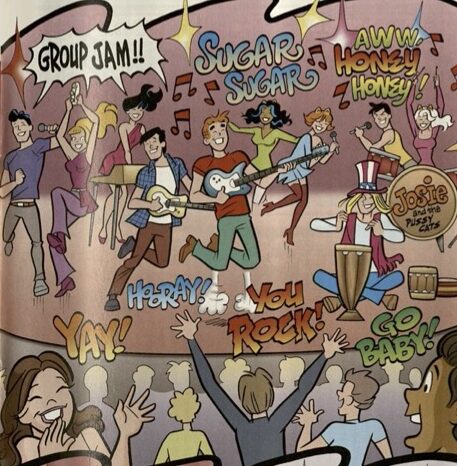
Archie: World Tour #653, “Rocking Canada,” March 5, 2014
Page 17
One of the most frequent uses of music to establish a landscape is in concert settings. This issue of Archie: World Tour includes a near splash page of the final performance of Josie and the Pussy Cats while in Canada, and visual depictions of music permeate the scene in a variety of ways. The band members each possess instruments or microphones and are illustrated in dynamic poses that suggest they are right in the middle of a song; the active poses of the audience members in mid-dance reinforce such an idea. Symbolic suggestions of music include the bright red music notes that float in between the musicians. All of these musical qualities of the scene come together to depict a lively and energetic concert environment.
View More Examples of Environment
Sergio Aragones Funnies #5, “The Piano”, November 23, 2011
Writer and Artist: Sergio Aragones
Colorist: Tom Luth, Nathan Kane, Nathan Hamill, Nathan Cristescu
Letterer: Karen Bates
Editor: Bill Morrison
Pages 16-20
“The Piano” is a wordless comic of a boy learning to play the piano after his parents see his infatuation with the instrument. The comic possesses multiple indications of the passage of time, including the aging of the boy and the change in location from his childhood home to a professional recital hall. However, perhaps the most prominent example of time is the growing complexity of the music itself, which floats over the boy as a symbolic representation of the music that he performs. The music transitions from a simple, single-staff melody with basic quarter notes to a multi-staff, multi-note concerto. These changes over the course of his life suggest his growth as a musician and are therefore the most important indication of time because they drive not only the passage of time but also the plot of the strip. The strip ends with a twist, as is the fashion with most wordless comics: he was not infatuated with the instrument but rather the woman that played the piano when he was a young boy.
Click on the blue circles to progress the pages.
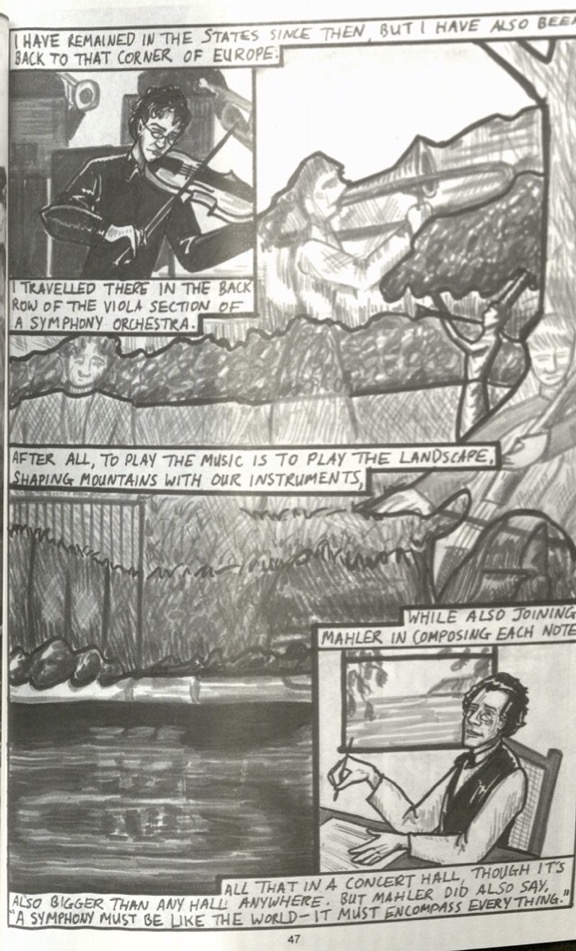
Side A: The Music Lovers Graphic Novel, “A Symphony Like the World,” 2006
Writer and Artist: J. C. Lozos
Page 47
This comic series demonstrates the relationship between environment and musical depictions explicitly by integrating musical instruments into the European landscape. The scenery includes a trombonist in the mountains, a cellist in the trees, a flute along the shoreline, and a trumpet in the water. Such a composition is an example of musical depictions that are not actually heard within the scene but rather included in order to establish the atmosphere of the comic, also known as non-diegetic. The idyllic, tranquil, and harmonious qualities of the landscape are reinforced by the presence of musicians all around. As the writer reflects, “to play the music is to play the landscape.”
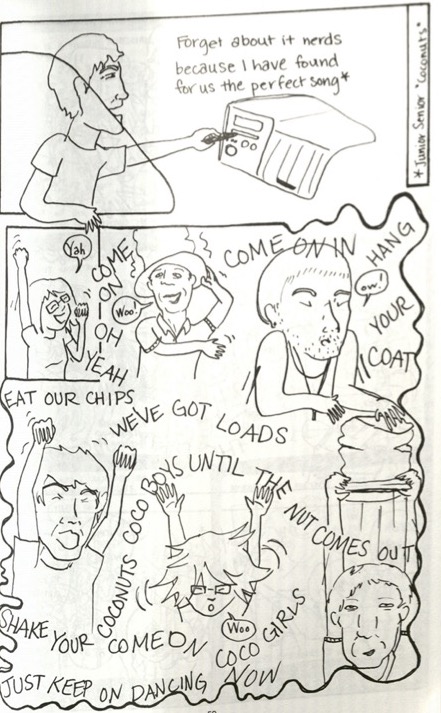
Side A: The Music Lovers Graphic Novel, “Fancy Dinner Party,” 2006
Writer and Artist: Sarah Morean
Page 59
Music provides a sense of environment to this party scene from Side A through the swirl and flow of the lyrics to Junior Senior’s “Coconuts” throughout the page. The lyrics comprise a significant portion of the panel, which implies that the music is heard throughout the room and is a clear source of the party’s energy. The body movements and dance poses of the party attendants underscore such energy. In addition to establishing the physical landscape of the comic, the song selection itself can help establish the environment by giving a sense of the time period. The song was written in 2002, so readers can infer that the setting of the comic is sometime in the early 2000s. Therefore, the inclusion of preexisting music in this comic adds to the setting in terms of both time and place.
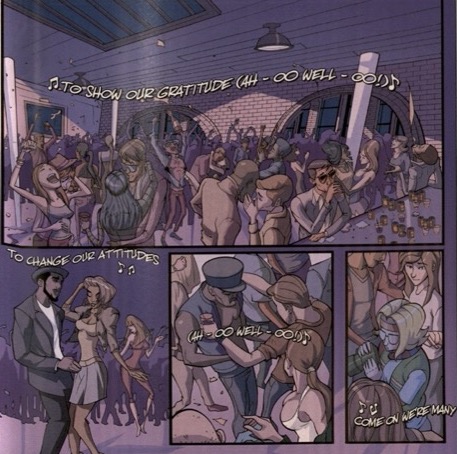
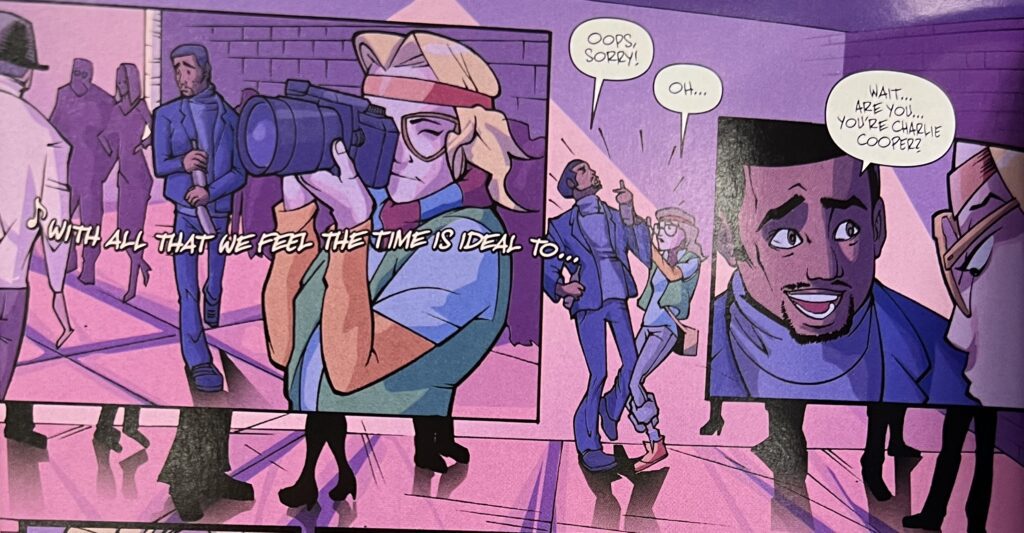
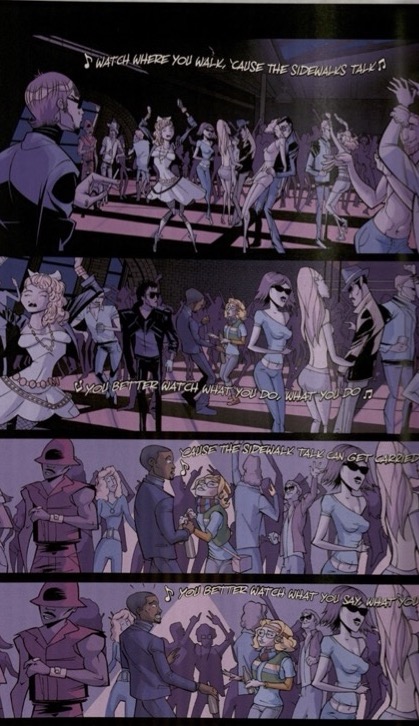
DMC #1, October 2014
Story By: Darryl DMC McDaniels and Damion Scott
Penciller and Inker: Felipe Smith
Colorist: Christopher Sotomayor
Publisher: Darryl DMC McDaniels
Pages 38-40
In this club scene, song lyrics float above the dancers and are framed with a musical notation to illustrate the presence of music. The lyrics are drawn with varying font sizes, and as the story progresses, the letters get smaller as the focus is pulled away from the environment of the scene and toward the action and dialogue of the characters. As a result, the setting, which is established through enlarged letters at the beginning, becomes peripheral to the plot, leading to both the environment and the lyrics shrinking in significance. With that being said, the form of musical depiction is still maintained in order to convey to readers that they are in the same environment that was established a few panels prior.
Characterization
Music can characterize both fictional and real-life people in comics. Fictional characters include Dazzler, a Marvel superhero whose powers come from hearing music, while real-life figures can range from Kurt Cobain to Charlie Parker. Music is integral to their character, so musical depictions are vital in demonstrating their skills, sentiments, and passions.
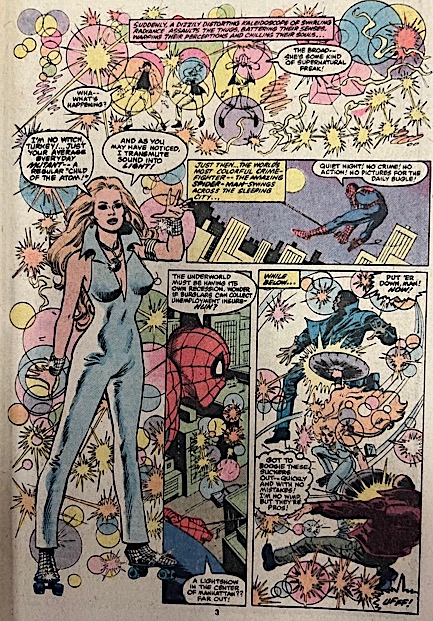
Dazzler #1A, “So Be This Star,” March 1981
Writer: Tom DeFalco
Penciller: John Romita Jr.
Inker: Alfredo P. Alfalfa
Colorist: Glynis Oliver-Wein
Letterer: Joe Rosen
Publisher: Marvel Comics
Page 3
The concept of music characterizing figures in comics is perhaps epitomized by Dazzler. As this page explains, Dazzler derives her mutant powers from music; hearing music allows her to produce intense colorful lights that “assault” any villains she encounters. Dazzler’s abilities are somewhat meta in their portrayal: the medium of comic books conveys hearing and sound through visual depictions, and Dazzler manifests hearing and sound into a visual power. Even the drawing of the power is emblematic of sound and music in that they are reminiscent of word balloons, motion and impact lines, and onomatopoetic explosion bubbles. In this way, Dazzler embodies the visual-aural interplay between the two senses.
View More Examples of Characterization
- Chasing the Bird
- Archie World Tour: Australia
- When I was an Alien 1
- When I was an Alien 2
- That Wilkin Boy
- Big Edsel Band
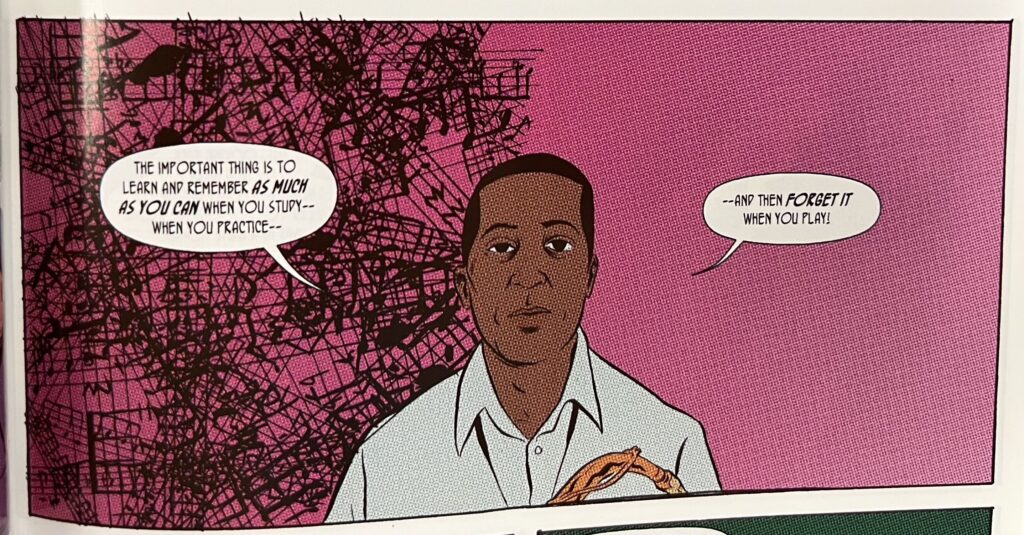
Chasing the Bird: Charlie Parker in California, 2020
Author: Dave Chisholm
Colors By: Peter Markowski
Publisher: Z2 Comics
Page 75
The depiction of Charlie Parker’s music-making process in this panel helps characterize his jazz musicianship. Parker describes to a group of partygoers that his music is rooted in the work of previous musical masterminds from his music education, from whom he tries to “remember as much as [he] can.” This musical knowledge is conveyed through a jumble of music notes and staves on the left-hand side of the panel. This depiction is then contrasted with the right-hand side, which is completely blank and reflective of his comment that a good musician “forgets” all of that education and training when they play. It is important to note that the music in this panel is non-diegetic, meaning that it is not heard by the characters in the scene and is instead a visualization of Parker’s inner thoughts. As a result, the readers learn about Parker’s inner psyche in addition to his understanding of music.
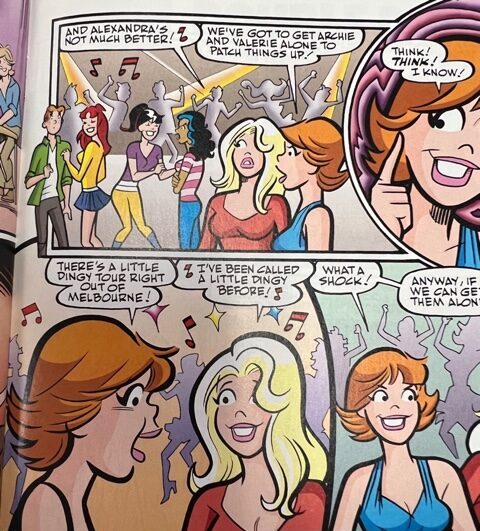
Archie: World Tour #652A, “Archie Down Under in Australia,” January 29, 2014
Page 13
Music defines the character of Melody in the Archie Comics series. As seen in this panel, as well as throughout the Archie: World Tour saga, Melody sings all of her dialogue, which is a reflection of her profession as a performer in the band Josie and the Pussycats. Her speech bubbles include red, cartoony eighth notes that demarcate her sung speeches and differentiate her lines from other characters. In this case, the depiction of the notes serves a similar purpose to the pun of her name, “Melody,” which is to reemphasize her musical personality.
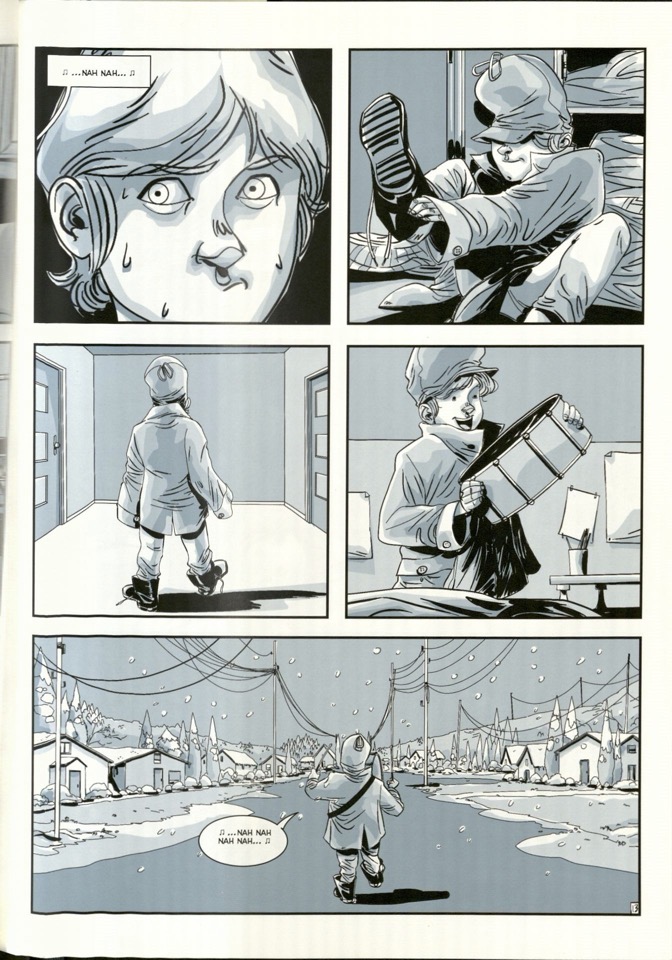
Kurt Cobain: When I was an Alien, 2013
Writer: Danilo Deninotti
Illustrator: Toni Bruno
Translated by: Antony Shugaar
Lettering: David’s Bertaina
Halftone: Mattie Zoanni
Page 13
Kurt Cobain: When I was an Alien is a biographical graphic novel exploring Kurt Cobain’s rise, successes, and struggles within the music industry. The entire novel features real songs that both influenced Cobain and were written by him. On this page, he sings “Hey Jude” by the Beatles to himself, which was a formative song that he heard early in his youth and would later inspire him to become a musician. This page not only reflects the ability of music in comics to characterize figures because it includes a song central to Cobain’s musical development, but also because of the way the page itself is composed. Cobain sings the song to himself incessantly throughout the day, as suggested through the series of time jumps between the panels, which illustrates his obsession with music and wandering brain, both of which are qualities that would come to define him as a vocalist and performer.
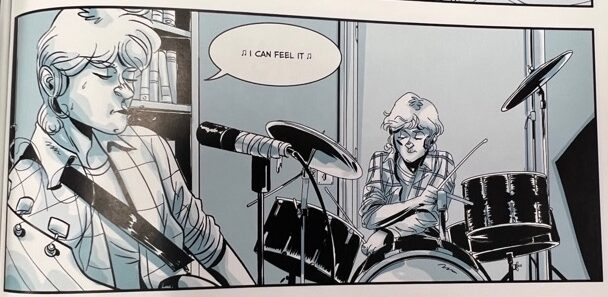
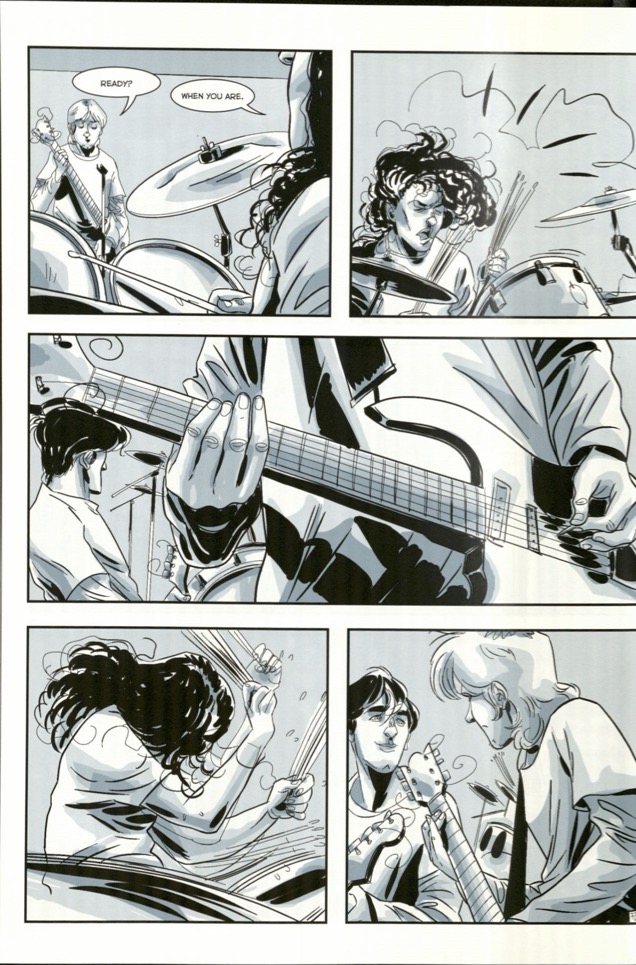
Kurt Cobain: When I was an Alien, 2013
Writer: Danilo Deninotti
Illustrator: Toni Bruno
Translated by: Antony Shugaar
Lettering: David’s Bertaina
Halftone: Mattie Zoanni
Pages 49 and 72
When I was an Alien utilizes music and musical performance to characterize members of Cobain’s band, such as David Grohl, as seen in the first and fourth panels on page 72. Grohl plays the drums with immense vigor, as evidenced by the amplitude of the motion lines that emanate from his drumsticks, his perspiration drops that fly from his face, and the wild, dynamic composition of his hair and body that move with the same intensity as his playing. Grohl contrasts the other drummers that have been depicted in previous pages of the novel in that his actions are much more energetic and impassioned. Such a contrast can be seen by both the relatively calm nature of the drummer on page 49 and the shocked facial reactions of Cobain and his bandmates in panel five of page 72 when they see Grohl play for the first time.
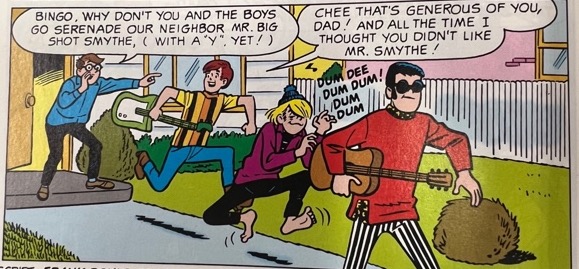
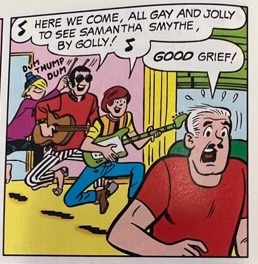
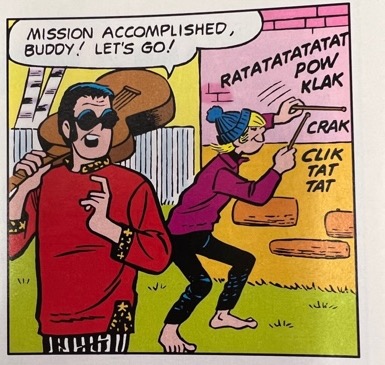
“That Wilkin Boy” in Archie: World Tour, “Bollywood Love,” December 4, 2013
Page 3-6
In “That Wilkin Boy,” the percussionist’s incessant drumming characterizes his role in the band. He speaks no dialogue but his presence is still known in nearly every scene through the “Rat-a-tat” and “dum-thump-dum” of his drumming. He plays on furniture, walls, and even people. The lack of dialogue means that his drumming becomes his closest source of a “voice,” which accentuates his position as the drummer of the group. In addition, his drumming is often a source of humor in the comic, which lightens the tone of the story and maintains the comedic quality of the plot.

Big Edsel Band #1, “Wrestle-Maniacs”, 1987
Writer: Frank McLaughlin
Artist: Frank McLaughlin and Win Mortimer
Letterer: Wayne Truman
Page 10
The comic series Big Edsel Band, which was an independent comic that portrayed the eponymous band in various shenanigans, drew inspiration from similar comics-based bands of the time (such as Josie and the Pussycats). On this page, the drummer is asked to play his instrument in order to prove the quality of the band. However, since the drummer is portrayed as a stereotypically idiotic character, he does not stop playing, and his drumming is even suggested to increase in intensity based on the growing size of the motion lines, even after the band members have moved to another conversation. While his overall character is somewhat cliche, the drums do serve their purpose in this scene of acting as the vessel through which the drummer can convey his foolishness.
